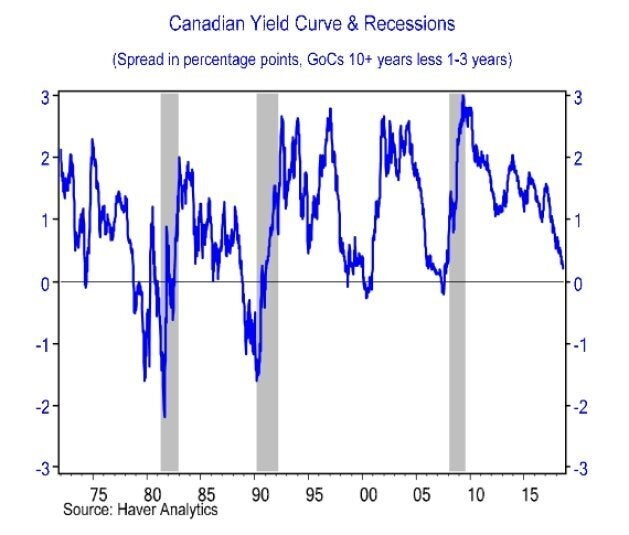
The Canadian economy has been on a hot streak recently, but a closely-watched indicator of tough times suggests the country may be in for an economic slowdown within the next two years.
The indicator that's flashing red is called the "yield curve," and it has to do with the interest paid on government debt.
What is a yield curve?
Like other governments, Canada issues bonds (i.e. borrows money) on the open market. Typically, buyers of those bonds demand a higher interest rate for long-term debt than for short-term debt.
That just makes sense: If you're going to lend for longer, you're taking a larger risk, so you demand more reward. This trend of interest rates rising for longer-term debt is called the "yield curve."
But sometimes, investors demand higher interest rates on short-term debt than on long-term debt. Analysts call this an "inverted yield curve," and it's taken very seriously because it's very good at predicting recessions.
In simplest terms, when the yield curve inverts, it means investors believe the economy will be weaker going forward. They see trouble ahead.
And since these people are the investor class who control a great deal of the flow of capital through the economy, when they believe tough times are ahead, it tends to become a self-fulfilling prophecy.
Canada's yield curve hasn't inverted yet, but the chart below, from Bank of Montreal, shows it's rapidly heading in that direction.
Note how, when the spread turns negative, there is often a recession shortly after (the gray areas on the chart). Today the spread is clearly headed towards negative territory.

How reliable is the yield curve in predicting hard times?
According to numbers crunched by Bloomberg, since 1961 Canada's yield curve has inverted 15 times, and 10 of those times were followed by at least one quarter of economic contraction. So in essence, it has a 66 per cent chance of correctly predicting a downturn.
Earlier on HuffPost Canada:
If Canada's yield curve does invert, "credit creation should slow down considerably, generating a negative feedback loop throughout the economy," wrote Aubrey Basdeo, head of Canadian fixed income at BlackRock, the world's largest asset management company, in a research note this week.
In other words, if the yield curve inverts, you can expect lending to slow down in the economy, making it harder to do things like get a mortgage or a car loan.
"The yield curve is something the Bank (of Canada) needs to pay attention to as far as that being a signal of the economy running into a brick wall sooner rather than later," Basdeo told Bloomberg news.
He predicted the Bank of Canada will stop raising interest rates as the economy weakens ahead, potentially good news for borrowers. But the markets are still pricing in an 80-per-cent chance of a rate hike in October.
Poloz not worried
The Bank of Canada has been brushing off concerns about the yield curve. Bank governor Stephen Poloz says this time is different: There is unusually high demand for long-term Government of Canada bonds, and that's causing investors to accept lower interest rates on those bonds, flattening the curve, Poloz says.
In downplaying it, Poloz could be taking a risk. "One should never dismiss the message from the yield curve," Bank of Montreal chief economist Doug Porter wrote in a client note this week.

Still, Porter noted that the yield curve is "a less air-tight, ultra-reliable forward indicator for Canada" than it is for the U.S. — which is also seeing a flattening of its yield curve, though not to the same extent as Canada.
"The curve is an early warning sign, but it's sometimes really early, and sometimes just a sign," Porter concluded.
What do I do if there is a recession ahead?
Keep calm and carry on, as the saying goes.
But don't ignore the risk. Now would be a good time to make sure you have a cushion of savings to help you get through tough times, such as the loss of a job.
If you don't have a cushion, consider spending a little less and saving a little more to build one up. (Though if everybody took this advice, it would cause consumer spending to slow, which could lead to a slowdown. Economics is messy stuff.)
Equally importantly, make sure your debt is under control. If you're carrying a lot of it, you are particularly at risk in an economic downturn. Look into debt consolidation, or talk to a financial planner, to help you come up with a budget that can help you get out of debt faster.